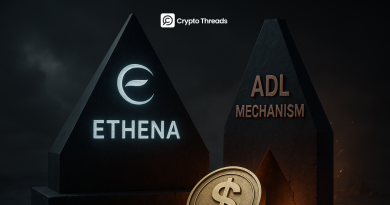MYX Finance Airdrop Scandal: $170M Sybil Attack & Insider Fraud
This article examines the MYX Finance scandal, where a $170M Sybil attack and insider fraud allegations shook DeFi. It explores how 100 wallets drained 1% of supply and why the case is now a turning point for token distribution security.
Executive Summary
On September 9, 2025, blockchain analytics firm Bubblemaps uncovered one of the largest Sybil attacks in cryptocurrency history. Around 100 wallets coordinated to claim 9.8 million MYX tokens worth approximately $170 million, equivalent to ~1% of supply.
The scandal escalated after Bubblemaps revealed direct links between these wallets and the creator’s wallet, fueling insider fraud allegations. MYX Finance’s vague response further eroded trust, with institutional investors offloading holdings and retail traders left exposed.
According to Coincu experts, this Sybil attack could prompt tighter regulatory oversight across the DeFi ecosystem. It has been described as a “wake-up call” for airdrop design, likely pushing projects to face greater legal scrutiny while accelerating technical innovations in Sybil resistance.
Background: MYX Finance and the “Project Origin” Program
Before diving into the scandal, it is essential to understand how MYX Finance was built and why its airdrop program became so exposed. The project’s structure, history, and early market reception explain both the scale of the hype and the vulnerabilities that followed.
Introduction to MYX Finance
MYX Finance is a decentralized derivatives exchange operating on Linea, Arbitrum, and BNB Chain. Its signature Matching Pool Mechanism (P2Pool2P) offers near zero-slippage trading with leverage up to 125x, positioning it as a highly efficient derivatives platform. Backed by Sequoia China (HongShan), Consensys, Hashkey, and OKX Ventures, the project raised over $10 million.

Earlier, the BMYX token collapsed 90%, sparking allegations of a rug pull that still shadowed the project.
The “Project Origin” Airdrop Mechanism
The program allocated 14.7% of supply (147M MYX) to early adopters. The Cambrian campaign rewarded trading, liquidity provision, retroactive BMYX holders, and testnet users. Multipliers boosted rewards for higher activity.
Distribution took place on BNB Chain. 30% unlocked at once, the rest vested over five months. The design aimed to reward genuine use but left loopholes. Insiders or coordinated groups could exploit the rules.
Market Interest and Hype
Investor demand was extreme. The IDO on Binance Wallet and PancakeSwap was oversubscribed 30,000%. Listings followed quickly on Binance Alpha Zone, Bitget, and PancakeSwap. By May, daily volume hit $51 million, placing MYX among the top tokens on BNB Chain.

Innovation, fragile trust, and unchecked hype created the perfect setup for one of the biggest Sybil attacks in DeFi history.
Forensic Analysis of the Sybil Attack
Let’s look closely at how the attack unfolded on-chain. The forensic trail, from wallet creation to token claims and finally to insider links, shows a level of coordination far beyond ordinary user activity.
Initial Discovery and Attack Pattern
Bubblemaps detected a cluster of around 100 newly created wallets that together claimed 9.8 million MYX tokens, equal to about 1% of the supply. Their activity was highly unusual and displayed tight coordination.
- Synchronized funding: At 6:50 AM on April 19, 2025, every wallet was funded from OKX with almost identical BNB balances, just enough to pay gas fees.
- Coordinated claiming: At 5:30 AM on May 7, 2025, the wallets executed claims nearly simultaneously, within seconds of each other.
- Lack of organic activity: No trading, staking, or interaction with other protocols appeared before or after the claims.
The timing, uniform gas loads, and absence of additional use all pointed to automation. This was a farm designed for one purpose: draining the airdrop.
In-Depth Technical Analysis
According to academic research on detecting Sybil addresses in blockchain airdrops, Sybil addresses typically exhibit consistent temporal characteristics including first transaction time, initial gas acquisition, airdrop participation activity, and final transaction. Every marker aligned perfectly.
Advanced behavioral modeling confirmed this. The pattern of transactions, the absence of diversification, and the identical timing across accounts indicated machine-level control. Over 40% of the addresses were classified as fake wallets created solely for token extraction.
This scale made the case remarkable. While small-scale Sybil farming is common in DeFi, running a synchronized cluster of 100 wallets requires significant resources, organization, and knowledge of the rules that govern the airdrop. The setup looked less like random exploitation and more like an engineered strategy.
Evidence of Insider Connections
The critical breakthrough in the investigation was discovering direct connections between the Sybil wallet cluster and the MYX creator’s wallet. The investigation revealed a clear path through transaction chains:
- Creator’s Wallet: Address 0x8eEB was identified as the official wallet of the MYX token creator
- Sybil Wallet: One of the Sybil wallets (address 0x4a31) sent $2.8 million worth of MYX tokens to deposit address 0xeb5A
- The Connecting Link: Deposit address 0xeb5A was also used by the MYX creator’s wallet, creating an undeniable connection
This connection was impossible to ignore. Regular users have no reason to route funds through the same deposit infrastructure as the token creator. The shared address indicated either a collapse in security standards or a direct overlap between insiders and the Sybil cluster.
In blockchain forensics, operational mistakes often reveal the truth. The use of a common deposit address blurred the line between project leadership and the attackers. Instead of distancing the team from the fraud, the link tied them to it, amplifying suspicion of insider involvement.
Response and Controversy
After Bubblemaps released its findings, attention quickly shifted to how MYX Finance would respond. The project’s reaction became a key test of credibility, as investors and the community wanted clear answers. Instead of restoring trust, the defense raised more questions and sparked even greater suspicion.
MYX Finance’s Defense
The team emphasized that airdrop distribution followed principles of fairness and openness. In their view, reward programs were designed around measurable activity such as trading volume and liquidity provision. Only the Cambrian campaign applied anti-Sybil filters targeting wash-trading bots.
They also revealed that certain participants had requested address changes before launch. High-volume traders were among them, and these requests were accepted. The team argued that heavy participation, even from a single entity, still represented valid engagement. Their official line read: “Even in cases where a single entity participates extensively, we acknowledge and respect that participation.”
Expert and Community Rebuttals
Bubblemaps pressed for clearer answers. The analytics team asked why the wallets acted with such precision and why one of them connected directly to the creator’s deposit address. For them, the official defense left the core issues untouched.
Community figures reacted with sharper criticism. Analysts described the response as empty and evasive, unworthy of a billion-dollar project. One widely shared comment summed up the mood: “Launch a token, run an airdrop, 100 Sybil addresses grab 1% of supply, valuation hits $20B, and the team replies with a long, vague GPT-style statement.”
Instead of easing tensions, the response amplified skepticism, leaving investors and observers more convinced that the scandal had not been addressed at its roots.
Market Impact and Price Manipulation
The scandal broke at the peak of a frenzy. MYX was already in the middle of a parabolic run, with prices soaring, leverage building, and retail money pouring in. A mix of hype, insider flows, and sudden token unlocks created the perfect setup for market manipulation.
Abnormal Price Surge
In the week leading up to the scandal, MYX token exploded. The price surged 1,320% in seven days, hitting a new all-time high. Market capitalization crossed $2.13 billion, with a fully diluted valuation of $17 billion.
From its low of $0.047 on June 19, MYX traded 350 times higher. The rally peaked during a major unlock, which released 39 million tokens into circulation. This mix of supply expansion and parabolic price action set the stage for chaos.
Market Manipulation Mechanisms
Momentum accelerated in early May. The token climbed 1,000% in just 48 hours, sparking a short squeeze that wiped out $40 million in liquidations. Analysts noted the timing: insiders appeared to use the rally to unload holdings into retail demand.
Charts showed the move clearly. Price leapt from $1.10 to $18.37 in less than a week. RSI hit 97, a level associated with extreme overbought conditions. Volume spiked across exchanges, driven by perpetual trading activity far larger than the project’s fundamentals.
Institutional Investor Response
Large investors reacted fast. On-chain data tracked Hack VC receiving $2.15 million in MYX from the airdrop. They sold $747,000 on the open market and moved another $1.48 million to MEXC. The flow signaled a sharp loss of confidence among institutional backers.
Their actions reinforced the view that the rally was unsustainable. While retail traders rushed to chase the breakout, major funds treated the spike as an exit opportunity.
Expert Opinions and Crypto Community Response
The MYX scandal ignited heated debate across the industry. Analysts, traders, and influencers dissected the rally and raised sharp allegations of manipulation. What emerged was a chorus of skepticism that spanned technical charts, on-chain data, and community sentiment.
Manipulation Allegations from Leading KOLs
Key voices quickly linked the surge to artificial activity. Dominic, a Web3 commentator with 44,000 followers on X, argued that whales and insiders engineered a pump-and-dump through wash trading, coordinated buying, and forced short squeezes. He noted that perpetual volumes suddenly spiked to $6–9 billion a day, far beyond what a token of MYX’s size should sustain.
VIKTOR echoed this view, calling the move a textbook case of manipulation driven by an ongoing short squeeze. Meanwhile, The Wolf of Altcoins, one of the larger accounts in the space, admitted being trapped. He had dollar-cost averaged during the rally with an entry around $3.03, only to find himself underwater as prices whipsawed.
Technical Analysis from Experts
From a technical angle, prominent traders also voiced concern. MrsBeastDeFi liquidated most of her position, warning of a brutal correction that could send MYX below one dollar. She described the rally as a setup designed to flush out short sellers rather than reflect genuine demand.
Budhil Vyas, a data scientist featured on CNBC, criticized MYX’s fundamentals. He highlighted its $2.6 billion valuation, a dead GitHub repository, lack of developer activity, and weak community presence. In his view, the project represented the height of 2025 speculation, where hype and trading games overshadow real value.
Warnings from Professional Traders
Market professionals also took defensive positions. Dry Martini, a widely followed analyst, revealed he had started shorting MYX. His reasoning was based on several indicators: the token reaching the top of its logarithmic growth channel, heavy liquidation clusters sitting just below current prices, and manipulation patterns in the order books.
Other traders described the rise as a controlled pump, likely to collapse once momentum faded. Public sentiment reflected the same unease. On Google, search queries such as “Is MYX Finance a scam?” and “How to spot crypto pump-and-dump schemes” began trending.
Market Analyst Perspectives
Long-term observers added more context. Dexter The Trader called the rally “complete madness,” pointing out that MYX had already gained more than 35,500% since its inception. He reminded audiences that the token had risen over 2,000% in a prior cycle and more than 1,300% in the current one, creating unsustainable conditions.
With the RSI at 97, analysts agreed the market was extremely overheated. Although no clear bearish divergence had appeared, the upside looked limited, and most expected a correction to follow.
Trading Community Skepticism
Skepticism deepened as traders compared the situation to Mantra (OM), which collapsed 90% in a single hour earlier in the year amid suspected insider activity. That crash erased $5.5 billion in value and left scars on the market.
Dominic reinforced the warning: “This is a classic pump-and-dump. Retail is the exit liquidity. Insiders have already cashed out.” He pointed to a past unlock where tokens surged from $3.9 million to $59.4 million in theoretical value before dropping 60% the following week.
Analysis of Unusual Activity
Another red flag came from social data. Despite the explosive rally, MYX did not see the usual spike in retail chatter. Mentions stayed flat, while only Key Opinion Leaders (KOLs) drove the conversation.
One analyst captured the concern: “How does a protocol with only $32 million in TVL suddenly generate $6–9 billion in daily derivatives volume? That gap alone makes the entire market nervous.”
Prevention Measures and Technical Solutions
The MYX scandal highlighted how vulnerable token distribution can be. To restore confidence, projects need stronger tools to detect Sybil activity and tougher rules to prevent large-scale exploitation. Several approaches are already proving effective across the industry.
Advanced Detection Techniques
Modern analysis begins with mapping wallets into transaction subgraphs. Each address is tracked by key lifecycle events: first funding, initial gas purchase, airdrop participation, and last transaction. Patterns that repeat with machine-like precision mark high-risk clusters.
Blockchain analytics platforms now combine these methods with AI-driven behavioral models. By scanning transaction histories, wallet interactions, and activity timing, they can flag groups of addresses likely controlled by a single operator. This gives projects early warning before tokens are drained by farms.
Preventive Measures
Projects are also experimenting with barriers that raise the cost of running Sybil farms. KYC checks, such as phone, card, or IP verification make it harder to spin up thousands of wallets. Economic friction is another tool: staking requirements or Proof of Work systems force attackers to commit resources, reducing incentives to cheat.
Some networks are testing proof of personhood, where each real user gets one verified identity. This model, though still controversial, promises a way to keep distribution fair without sacrificing decentralization.
Successfully Deployed Solutions
Real-world cases show these measures in action. LayerZero worked with Nansen to track wallet clusters and disqualify Sybil addresses. The team also launched a bounty program, paying community members to hunt down fake wallets.
The Optimism Foundation ran a large-scale crackdown of its own, cutting more than 17,000 Sybil addresses and reallocating 14 million OP tokens. The move limited the influence of attackers and redistributed rewards to genuine users.
These examples underline a key lesson: strong defenses are possible, but they require a mix of analytics, economic barriers, and community enforcement.
Legal and Regulatory Implications
We can see the MYX case is more than a single scandal. Large-scale Sybil attacks strike at the core of market fairness and transparency. When billions move through manipulated schemes, regulators cannot ignore the risks. Because the fallout from MYX is likely to accelerate oversight across DeFi.
Regulatory Impact
Authorities see these incidents as evidence that token distribution is not self-correcting. The scale of the MYX exploit will push regulators to demand clear audit trails and anti-fraud systems before new tokens hit the market. Frameworks under the SEC, MiCA in Europe, and HKMA in Asia are expected to treat airdrops as events requiring compliance checks similar to fundraising rounds.
Startups that fail to anticipate these demands risk being sidelined. By contrast, projects that design tokenomics with accountability in mind can gain trust and avoid enforcement.
Future of Token Distribution
The industrialization of Sybil attacks makes “airdrop farming” a systemic problem. Weak defenses let attackers capture supply long before retail investors or real users benefit. This undermines both fairness and sustainability.
Future distribution will likely become more selective. Instead of open giveaways, projects may adopt tiered systems with multiple verification stages, community scoring, or utility-based rewards. Incentives will shift from sheer activity to quality of engagement.
The MYX scandal shows what happens when design flaws collide with unchecked speculation. For DeFi to mature, airdrops must evolve from hype machines into structured entry points that balance growth with integrity.
Comparative Analysis with Similar Cases
In reality, Sybil attacks have long haunted crypto, but the MYX scandal exposed their scale with unmatched clarity. Let’s look at earlier cases to see how this one redefines the threat.
Other Notable Cases
In 2020, the Ethereum Classic network was compromised when attackers gained majority hash power. This allowed double-spend attacks worth more than $5 million. The incident showed how fragile smaller proof-of-work chains could be.
In 2022, the Solana network suffered a Sybil-driven exploit that drained more than $5 million. Attackers leveraged network vulnerabilities to overwhelm resources, proving that even high-performance chains were not immune.
More recently, large airdrop campaigns have faced similar challenges. Optimism disqualified 17,000 addresses during its first token distribution. Arbitrum faced criticism when whales farmed rewards through dozens of wallets, sparking debates about fairness.
Unique Characteristics of the MYX Case
The MYX case stands apart for both size and sophistication. Nearly $170 million in tokens were captured by a tightly coordinated cluster of wallets. On-chain analysis also revealed direct ties to the project creator, an element rarely seen in prior scandals.
Unlike attacks on consensus mechanisms, this was a strike against token distribution design itself. The operation was not about breaking the chain, but about exploiting rules crafted by the project. That difference places MYX in a category of its own.
The incident now serves as the largest known airdrop Sybil attack, and possibly the clearest example of how weak incentives, unchecked hype, and insider overlap can destabilize an entire launch.
Conclusion
The MYX Finance scandal stands as the largest airdrop Sybil attack to date. Roughly 100 wallets captured close to $200 million in tokens, a breach that exposed just how fragile token distribution has become in DeFi. It was not only a hit to one project’s reputation but a clear warning to the entire industry.
This case shows that airdrops without strong defenses invite exploitation. Loopholes and insider shadows can turn growth campaigns into market disasters. The lesson is simple: projects must build distribution systems that are secure, transparent, and resistant to manipulation.
DeFi now faces a choice. Learn from MYX and strengthen the foundation, or risk watching trust erode with every new scandal. The future of token distribution depends on action taken today.



